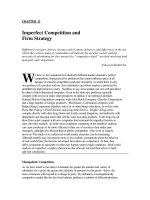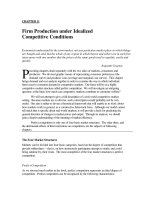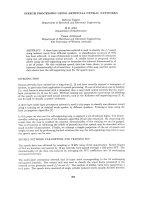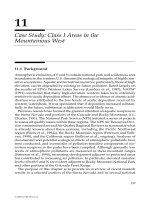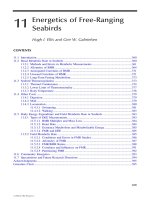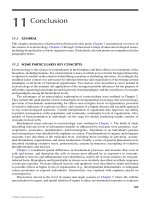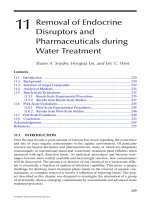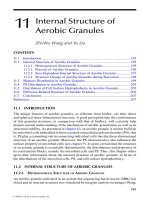Chapter 11 idelaized competition
Bạn đang xem bản rút gọn của tài liệu. Xem và tải ngay bản đầy đủ của tài liệu tại đây (1.11 MB, 26 trang )
CHAPTER 11
Firm Production under Idealized
Competitive Conditions
Economists understand by the term market, not any particular market place in which things
are bought and sold, but the whole of any region in which buyers and sellers are in such free
intercourse with one another that the prices of the same goods tend to equality, easily and
quickly.
Augustin Cournot
P
receding chapters dealt separately with the two sides of markets, consumers and
producers. We devised graphic means of representing consumer preferences (the
demand curve) and producer costs (average and marginal cost curves). This chapter
brings demand and cost analysis together in order to examine the way in which individual
firms react to consumer demand in competitive markets. Our focus will be on a highly
competitive market structure called perfect competition. We will investigate an intriguing
question: at the limit, how much can competitive markets contribute to consumer welfare?
We will not attempt to give a full description of a real-world competitive market
setting. Because markets are so diverse, such a description would probably not be very
useful. Our aim is rather to devise a theoretical framework that will enable us to think about
how markets work in general, as a constructive behavioral force. Although our model cannot
tell much that is specific about real-world markets, it will provide a basis for predicting the
general direction of changes in market prices and output. Through its analysis, we should
gain a deeper understanding of the meaning of market efficiency.
Perfect competition is only one of four basic market structures. The other three, and
the detrimental effects of their restrictions on competition, are the subjects of following
chapters.
The Four Market Structures
Markets can be divided into four basic categories, based on the degree of competition that
prevails within them -- that is, on how strenuously participants attempt to outdo, and avoid
being outdone by, their rivals. The most competitive of the four market structures is perfect
competition.
Perfect Competition
As we stressed much earlier in the book, perfect competition represents an ideal degree of
competition. Perfect competition can be recognized by the following characteristics:
Chapter 11 Firm Production under Idealized
Competitive Conditions
1.
There are many producers in the market, no one of which is large enough to
affect the going market price for the product. All producers are price takers,
as opposed to price searchers or price makers (see the Perspective on the
subject below).
2.
All producers sell a homogeneous product, meaning that the goods of one
producer are indistinguishable from those of all others. Consumers are fully
knowledgeable about the prices charged by different producers and are totally
indifferent as to which producer they buy from.
3.
Producers enjoy complete freedom of entry into and exit from the market—
that is, entry and exit costs are minimal, although not completely absent.
4.
There are many consumers in the market, no one of whom is powerful enough
to affect the market price of the product. Like producers, consumers are price
takers.
As we have seen before, the demand curve facing the individual perfect competitor is
not the same as the demand curve faced by all producers. The market demand curve slopes
downward, as shown in Figure 11.1(a). The demand curve facing an individual producer -price taker -- is horizontal, as in Figure 11.1(b). This horizontal demand curve is perfectly
elastic. That is, the individual firm cannot raise its price even slightly above the going
market price without losing all its customers to the numerous other producers in the market
or to other producers waiting for an opportunity to enter the market. On the other hand, the
individual firm can sell all it wishes at the going market price. Hence it has no reason to
offer its output at a lower price. The markets for wheat and for integrated computer circuits,
or computer chips, are both good examples of real-world markets that come close to perfect
competition.
Pure Monopoly
Pure monopoly: A single seller of a product for which there are no close substitutes.
Protected from competition by barriers to entry into the market. The barriers to entry into the
monopolist’s market will be described in the next chapter. For now, we will simply note that
because the monopolistic firm does not have to worry about competitors undercutting its
price, it can raise its price without fear that customers will move to other producers of the
same product or similar products. All the pure monopolist has to worry about is losing
customers to producers of distantly related products.
Since the monopolist is the only producer of a particular good, the downward-sloping
market demand curve [Figure 11.1(a)] is its individual demand curve. Unlike the perfect
competitor, the monopolistic firm can raise its price and sell less, or lower its price and sell
more. The critical task of the pure monopolist is to determine the one price-quantity
combination of all price-quantity combinations on its demand curve that maximizes its
profits. In this sense the pure monopolist is a price searcher. The best (but not perfect) realworld examples of a pure monopoly are regulated electric-power companies, which dominate
in given geographical areas, and the government’s first-class postal system.
Chapter 11 Firm Production under Idealized
Competitive Conditions
FIGURE 11.1 Demand Curve Faced by Perfect Competitors
The market demand for a product part (a) is always downward sloping. The perfect competitor is on a
horizontal, or perfectly elastic, demand curve [part (b)]. It cannot raise its price above the market price even
slightly without losing its customers to other producers.
Monopolistic Competition
Monopolistic competition is a market composed of a number of producers whose products
are differentiated and who face highly elastic, but not perfectly elastic, demand curves.
A monopolistically competitive market can be recognized by the following
characteristics:
1. There are a number of competitors, producing slightly different products.
2. Advertising and other forms of nonprice competition are prevalent.
3. Entry into the market is not barred but is restricted by modest entry costs, mainly
overhead.
4. Because of the existence of close substitutes, customers can turn to other
producers if a monopolistically competitive firm raises its price. Because of brand
loyalty, the monopolistic competitor’s demand curve still slopes downward; but it is
fairly elastic [see Figure 11.2).
The market for textbooks is a good example of monopolistic competition. Most subjects are
covered by two or three dozen textbooks, differing from one another in content, style of
presentation, and design.
Chapter 11 Firm Production under Idealized
Competitive Conditions
PERSPECTIVE: Price Takers and Price Searchers
Perfect competition is an extreme degree of competition, so much so that many students are understandably
concerned about its relevance. They often ask, “If there are few market structures that even closely approximate
perfect competition, why bother to study it?” The question is a good one and not altogether easy to answer.
There are few markets that come close to having numerous producers of an identical product with complete
freedom of entry and exit. Markets for agricultural commodities and for stocks and bonds are probably the
closet markets we have to perfect competition, but still the products are not always completely identical, and
entry and exit costs abound in most markets. Even wheat sold by a Kansas wheat farmer us not always viewed
the same as wheat sold by a Texas wheat farmer.
How can sense be made of perfect competition? The answer is remarkably simple. We know that under the
conditions of competition specified, certain results follow. We can logically (with the use of graphs and
mathematics) derive them, and the results are developed in this and the following chapter. One conclusion
drawn is that in perfect competition each firm will extend production until the marginal cost of producing the
last unit equals the price paid by the consumer. That conclusion necessarily follows. As we will see, it is
mathematically valid. The strict (extreme) assumptions about the nature of perfect competition assure that.
The demanding conditions for perfect competition are rarely met. We nevertheless cannot conclude that
under less demanding competitive conditions, competitive results would not be observed. [see the Perspectives
on contestable markets on page 240.) For example, it may be that the number of producers is not “numerous”
that the products sold by all producers are not completely “identical,” and that there are costs to moving in and
out of markets. Nonetheless, individual producers may act as if the conditions of perfect competition are met.
Individual producers may still act as if they have no control over market price or that there are so many other
actual or potential producers that it is best to think in terms of the other producers being numerous”—in which
case many of the predicted results of perfect competition may be still observed in the less-than-perfect markets.
For these reasons, many economists often talk not about perfect competitors but about price takers (who may
or may not fit exactly the description of perfect competitors). Price takers are sellers who do not believe they
can control the market price by varying their own production levels. They simply observe the market price and
either accept it (and produce accordingly, to the point where marginal cost and marginal revenue and price are
equal) or reject it (and go into some other business). The price taker is someone who acts as if his or her demand
curve is horizontal (perfectly elastic, more or less). He or she is therefore someone who assumes the marginal
revenue on each unit sold is constant (and equal to the price)—and that the marginal revenue curve is horizontal
and the same as the firm’s demand curve.
The price searcher stands in contrast to the price taker. Price searchers are sellers who have some control
over the market price. Price searchers have monopoly power due to the fact that they can alter production and
thereby market supply sufficiently to change the price. The individual price searcher’s task is not simply to
accept or reject the current market price, but (like the monopolist) to “search” through the various price-quantity
combinations on his or her downward sloping demand curve with the intent upon maximizing profits. As we
will see in the following chapter, the marginal revenue and demand curves of the price searcher are no longer the
same. (Exactly where the monopolist’s marginal revenue curve lies in relation to the demand curve will be
discussed in detail in the next chapter).
Chapter 11 Firm Production under Idealized
Competitive Conditions
________________________________________
FIGURE 11.2 Demand Curve Faced by a
Monopolistic Competitor
Because the product sold by the monopolistically
competitive firm is slightly different from the
products sold by competing producers, the firm
faces a highly elastic, but not perfectly elastic,
demand curve.
Oligopoly
An oligopoly is a market composed of only a handful of dominant producers—as few as
two—whose pricing decisions are interdependent. Oligopolists may produce either an
identical product (like steel) or highly differentiated products (like automobiles). Generally
the barriers to entry into the market are considerable, but the critical characteristic of
oligopolistic firms is that their pricing decisions are interdependent. That is, the pricing
decisions of any one firm can substantially affect the sales of the others. Therefore, each
firm must monitor and respond to the pricing and production decisions of the other firms in
the industry. The importance of this characteristic will become clear in a following chapter.
Table 11.1 summaries the characteristics of the four market structures.
The Perfect Competitor’s Production Decision
As we learned earlier, the market price in a perfectly competitive market is determined by the
intersection of the supply and demand curves. If the price is above the equilibrium price
level, a surplus will develop forcing competitors to lower their prices. If the price is below
equilibrium, a shortage will emerge, pushing the price upward [see Figure 11.3(a)]. Given a
market price over which it has no control, how much will the individual perfect competitor
produce?
The Production Rule: MC = MR
Suppose the price in the perfectly competitive market for computer chips $5 (P1 in Figure
11.3). For each individual competitor, the market price is given, that is, cannot be changed.
It must be either accepted or rejected. If the firm rejects the price, however, it must shut
down. If it raises its price even slightly above the market level, its customers will move to
other competitors.) Demand, then, is horizontal at $5.
Chapter 11 Firm Production under Idealized
Competitive Conditions
Table 11.1 Characteristics of the Four Market Structures.
Freedom of
Entry
Very easy
Type of Product
Perfect competition
Number of
Firms
Many
Pure monopoly
One
Barred
Single product
Monopolistic competition
Many
Relatively easy
Differentiated
Oligopoly
Few
Difficult
Either standardized
or differentiated
Homogeneous
Example
Wheat,
Computers,
and
Gold
Public utilities
and
Postal service
Pens,
Books,
Paper, and
Clothing
Steel,
Light bulbs,
Cereal, and
Autos
_____________________________________________________________________
The firm’s perfectly elastic horizontal demand curve is illustrated on the right side of
Figure 11.3. This horizontal demand curve is also the firm’s marginal revenue curve,
because marginal revenue is defined as the additional revenue acquired from selling one
additional unit. Because each computer chip can be sold at a constant price of $5, the
additional, or marginal, revenue acquired from selling an additional unit must be constant at
$5.
Because profit equals total revenue minus total cost (profit = TR = TC), the profitmaximizing firm will produce any unit for which marginal revenue exceeds marginal cost.
Thus the profit-maximizing firm in Figure 11.3(b) will produce and sell q1 units, the quantity
at which marginal revenue equals marginal cost (MR = MC). Up to q1 , marginal revenue is
greater than marginal cost. Beyond q1 , all additional computer chips are unprofitable: the
additional cost of producing them is greater than the additional revenue acquired [with the
small “q” being used to remind you that the output individual producer in Figure 11.3(b) is a
small fraction of the output for the market, designated by a capital “Q” in Figure 11.3 (a)].
Changes in Market Price
The perfectly competitive firm produces where MC = MR, both of which are equal to price.
Thus the amount the firm produces depends on market price. As long as market demand
remains constant, the individual firm’s demand, and its price, will also remain constant. If
market demand and price increase, however, the individual firm’s demand and price will also
increase.
Chapter 11 Firm Production under Idealized
Competitive Conditions
FIGURE 11.3 The Perfect Competitor’s Production Decision
The perfect competitor’s price is determined by market supply and demand [part (a)]. As long as
marginal revenue (MR), which equals market price, exceeds marginal cost (MC), the perfect
competitor will expand production [part (b)]. The profit-maximizing production level is the point
at which marginal cost equals marginal revenue (price).
FIGURE 11.4 Change in the Perfect Competitor’s Market Price
If the market demand rises from D1 to D3 [part (a)], the price will rise with it, from P1 to P3 . As a
result, the perfectly competitive firm’s demand curve will rise, from d1 to d3 [part (b)].
Chapter 11 Firm Production under Idealized
Competitive Conditions
Figure 11.4 (above) shows how the shift occurs. The original market demand of D1
leads to a market price of P1 [part (a)], which is translated into the individual firm’s demand,
d1 [part (b)]. The firm maximizes profit by equating marginal cost with marginal revenue,
which is equal to d1 , at an output level of q1 .1
An increase in market demand to D2 leads to the higher price P2 and a higher
individual demand curve, d2 . At this higher price, which equals marginal revenue, the perfect
competitor can support a higher marginal cost. The firm will expand production from q1 to
q2 . In the same way, an even greater market demand, D3 , will lead to even higher output, q3 ,
by the individual competitor.
Why does the market supply curve slope upward and to the right? The answer lies in
the upward-sloping marginal cost curves confronted by individual firms. (The market supply
curve is obtained by horizontally adding the supply curves of individual firms.) The
individual firm’s marginal cost curves slope upward because of diminishing (marginal)
returns, a technological fact of the production process.
Maximizing Short-Run Profits
Can perfect competitors make an economic profit? The answer is yes, at least in the short
run. To see this point, we must incorporate the average and marginal cost curves developed
in the last chapter into our graph of the perfect competitor’s demand curve, as in Figure
11.5(b). [Figure 11.5(a) shows the market supply and demand curves.) As before, the
producer maximizes profits by equating marginal cost with price, rather than by looking at
average cost. That is exactly what the perfect competitor does. The firm produces q2
computer chips because that is the point at which marginal revenue curve (which equals the
firm’s demand curve crosses the marginal cost curve. At that intersection, marginal revenue
of the last unit sold equals its marginal cost. If less were produced that q1 , the marginal cost
would be less than the marginal revenue, and profits would be lost. Similarly, by producing
anything more than q2 , the firm incurs more additional costs (as indicated by the marginal
1
To prove this statement, first we note that
TR = PQ
Then we define short-run total cost to be a function of output:
SRTC = C (Q)
Next, we define profits π to be
π = TR − SRTC = PQ − C( Q)
Differentiating with respect to Q and equating with 0, we then obtain
dπ
dC( Q)
= P−
=0
dQ
dQ
dC(Q)
P=
dQ
dC( Q)
Since
= SRMC, profits are maximized when SRMC = P .
dQ
Chapter 11 Firm Production under Idealized
Competitive Conditions
cost curve) than it receives in additional revenue (as indicated by the demand curve, which
beyond q2 is below the MC curve).
At q2 (and anywhere else), the firm’s profit equals total revenue minus total cost (TR
– TC). To find total revenue, we multiply the price, P1 (which also equals average revenue)
by the quantity produced, q2 (TR = P1q2 ). Graphically, total revenue is equal to the area of
the rectangle bounded by the price and quantity, or 0P1aq2 .
Similarly, total cost can be found by multiplying the average total cost of production
(ATC) by the quantity produced. The ATC curve shows us that the average total cost of
producing q2 computer chips is ATC1 . Therefore total cost is ATC1q2 , or the rectangular area
bounded by 0ATC1 bq2 . The profits of the company are therefore P1q2 – ATC1 q2 , which is the
same, mathematically, as q2 (P1 – ATC1 ). This quantity corresponds to the area representing
total revenue, OP1 aq2 , minus the area representing total cost, 0ATC1 bq2 . Profit is the shaded
rectangle bounded by ATC1 P1 ab.
FIGURE 11.5 The Profit-Maximizing Perfect Competitor
The perfect competitor’s demand curve is established by the market-clearing price [part (a)]. The
profit-maximizing perfect competitor will extend production up to the point where marginal cost
equals marginal revenue (price), or point a in part (b). At that output level—q2—the firm will earn a
short-run economic profit equal to the shaded area ATC 1 P1ab. If the perfect competitor were to
minimize average total cost, it would produce only q 1 , losing profits equal to the darker shaded area
dca in the process.
The perfect competitor does not seek to produce the quantity that results in the lowest
average total cost. That quantity, q1 , is defined by the intersection of the marginal cost curve
and the average total cost curve. If it produced only q1 , the firm would lose out on some of
its profits, shown by the darker shaded area dca. (Suppose the firm is producing at q1 . If it
expands production to q2 , it will generate P1 times q2 – q1 in extra revenue (price times the
additional units sold), an amount represented graphically by the area q1 daq2 .)
Chapter 11 Firm Production under Idealized
Competitive Conditions
Naturally, profit-maximizing firms will attempt to minimize their costs of production.
That does not mean they will produce at the point of minimum average total cost. Instead,
the will try to employ the most efficient technology available and to minimize their payments
for resources. That is they will attempt to keep their cost curves as low as possible. But
given those curves, the firm will produce where MC = MR, not where ATC is at its lowest
level. Managers who cannot distinguish between those two objectives will probably operate
their businesses on a less profitable basis than they might—and will risk being run out of
business.
Minimizing Short-Run Losses
In the foregoing analysis the market-determined price was higher than the firm’s average
total cost, allowing it to make a profit. Perfect competitors are not guaranteed profits,
however. The market price may not be high enough for the firm to make a profit. Suppose,
for example, that the market price is P1 , below the firm’s average total cost curve [see Figure
11.6). Should the firm still produce where marginal cost equals marginal revenue (price)?
The answer, for the short run, is yes. As long as the firm can cover its variable cost, it should
produce q1 computer chips.
FIGURE 11.6 The Loss-Minimizing Perfect Competitor
The market-clearing price [part (a)] establishes the perfect competitor’s demand curve [part (b)]. Because the
price is below the average total cost curve, this firm is losing money. As long as the price is above the low
point of the average variable cost curve, however, the firm should minimize its short-run losses by continuing to
produce where marginal cost equals marginal revenue [price or point b in part (b)]. This perfect competitor
should produce q 1 units, incurring losses equal to the shaded area P1 ATC 1 ab. (The alternative would be to shut
down, in which case the firm would lose all its fixed costs.)
It is true that the firm will lose money. Its total revenues are only P1q1 , or the area
bounded y 0P1 bq1 , whereas its total costs are ATC1 q1 , or the area 0ATC1 aq1 , whereas its total
Chapter 11 Firm Production under Idealized
Competitive Conditions
costs are ATC1 q1 , or the area 0ATC1 aq1 . On the graph its total losses equal the difference
between those two rectangular areas, the shaded area bounded by P1 ATC1 ab. Whether the
firm incurs losses is not the relevant question, however. The real issue is whether the firm
loses more money by shutting down or by operating and producing q1 chips.
In the short run, the firm will continue to incur fixed costs even if it shuts down. If it
is not earning any revenues, its losses will equal its total fixed costs. In the last chapter we
saw that the average fixed cost of production is the vertical distance between the average
variable cost and average total cost.
In short, as long as the price is higher than average variable cost—if the price more
than covers the cost associated directly with production—the firm minimizes its short-run
losses by producing where marginal cost equals marginal revenue. Only if the price dips
below the low point of the average variable cost curve—where the marginal and average
variable cost curves intersect—will the firm add to its losses by operating. The firm will shut
down when price is at or below that point, Ps in Figure 11.6. At prices above that point, the
firm simply follows its marginal cost curve to determine its production level. Above the
average variable cost curve, then, the marginal cost curve is in effect the firm’s supply curve.
Therefore, if a perfect competitor produces at all, it produces in a range of increasing
marginal cost—and diminishing marginal returns.
Our analysis has shown why, in the short run, fixed costs should be ignored. The
relevant question is whether a given productive activity will add more to the firm’s revenues
than to its costs. Understanding this principle, businesses may undertake activities that
superficially appear to be quite unprofitable. Some grocery stores stay open all night, even
though the owners known they will attract few customers. If all costs, including fixed costs,
are considered, the decision to operate in the early morning hours may seem misguided. The
only relevant question facing the store manager is whether the additional sales generated are
greater than the additional cost of light, goods sold, and labor. Similarly, many businesses
that are obviously failing continue to operate, for by staying open they can at least cover a
portion of their fixed costs—such as rent—that would still be due if they shut down. They
stay open until their leases expire or until they can sell out.
Producing Over the Long Run
In the long run businesses have an opportunity to change their total fixed costs. If the market
price remains too low to permit profitable operation, a firm can eliminate its fixed costs, sell
its plant and equipment, or terminate its contracts for insurance and office space. If the
market price is above average total cost, new firms can enter the market, and existing firms
can expand their scale of operation. Such long-run adjustments in turn affect market supply,
which affects price and short-run production decisions.
Chapter 11 Firm Production under Idealized
Competitive Conditions
The Long-Run Effect of Short-Run Profits and Losses
When profits encourage new firms to enter an industry and existing firms to expand, the
result is an increase in market supply, a decrease in market price, and a decrease in the
profitability of individual firms. For example, in Figure 11.7(a), the existence of economic
profits in the computer chip market means that investors can earn more in that industry than
in some others. Some investors will move their resources to the computer chip industry.
Because the number of producers increases, the supply curve shifts outward, expanding total
production from Q1 to Q2 and depressing the market price from P2 to P1 .
The expansion of industry supply and the resulting reduction in market price make
the computer chip business less profitable for individual firms. The lower market price is
reflected in a downward shift of the firm’s horizontal demand curve, from d1 to d2 [see
Figure 11.7(b)]. The individual firm reduces it output from q2 to q1 , the intersection of the
new marginal revenue (price/demand) curve with the marginal cost curve. Note that q1 is
also the low point of the average total cost curve. Here price equals average total cost,
meaning that economic profit is zero. The firm is making just enough to cover its
opportunity and risk costs, but no more.
Losses have the opposite effect on long-run industry supply. In the long run, firms
that are losing money will move out of the industry, because their resources can be employed
more profitably elsewhere. When firms drop out of the industry, supply contracts and total
FIGURE 11.7 The Long-Run Effects of Short-Run Profits
If perfect competitors are making short-run profits, other producers will enter the market, increasing the market
supply from S 1 to S 2 and lowering the market price, from P2 to P1 part (a). The individual firm’s demand curve,
which is determined by market price will shift down, from d 1 to d 2 [part (b)]. The firm will reduce its output
from q 2 to q 1 , the new intersection of marginal revenue (price) and marginal cost. Long-run equilibrium will be
achieved when the price falls to the low point of the firm’s average total cost curve, eliminating economic profit
[price P1 in (b)].
Chapter 11 Firm Production under Idealized
Competitive Conditions
production falls, from Q2 to Q1 in Figure 11.8(a). As a result, the price of the product rises,
permitting some firms to break even and stay in the business. Long-run equilibrium occurs
when the price reaches P2 , where the individual firm’s demand curve is tangent to the low
point of the average total cost curve [Figure 11.8(b)]. The output of each remaining
individual firm expands (from q1 to q2 ) to take up the slack left by the firms that have
withdrawn. Again price and average total cost are equal, and economic profit is zero.
FIGURE 11.8 The Long-Run Effects of Short-Run Losses
If perfect competitors are suffering short-run losses, some firms will leave the industry causing the market
supply to shift back from S 1 to S 2 and the price to rise, from P1 to P2 part (a). The individual firm’s demand
curve will shift up with price, from d 1 to d 2 [part (b)]. The firm will expand from q 1 to q 2 , and equilibrium will
be reached when price equals the low point of average total cost P2 , eliminating the firm’s short-run losses.
The Effect of Economies of Scale
In the long run, competition forces firms to take advantage of economies of scale, if they
exist. If expanding the use of resources reduces costs, the perfect competitor must expand.
Otherwise, other firms will expand their scale of operation, increasing market supply and
forcing the market price down. Any firm that does not expand its scale will be caught with a
cost structure that is higher than the market price. In addition to mere self-preservation, the
firm also has a profit incentive for expansion. If it expands before other firms, its lower
average total cost will allow it to make greater profits for a short period of time.
Consider Figure 11.9, for instance. Initially the market is in short-run equilibrium at
a price of P2 [part (a)]. The individual firm is on cost scale ATC1 , producing q1 chips and
breaking even [part (b)]. If the firm expands its scale of operation and produces where its
demand curve d1 intersects the long-run marginal cost curve, it will make a profit equal
graphically to the shaded area ATC1 P2 ab. That is the firm’s incentive for expansion.
Chapter 11 Firm Production under Idealized
Competitive Conditions
FIGURE 11.9 The Long-Run Effects of Economies of Scale
If the market is in equilibrium at price P1 in part (a). and the individual firm is producing q 1 units on short -run
average total cost curve ATC 1 [part (b)], firms will be just breaking even. Because of the profit potential
represented by the shaded area ATC 1 P2 ab, firms can be expected to expand production to q 3 , where the long-run
marginal cost curve intersects the demand curve (d 1 ). As they expand production to take advantage of
economies of scale, however, supply will expand from S 1 to S 2 in part (a), pushing the market price down
toward P1 , the low point of the long-run average total cost curve (LRAC). Economic profit will fall to zero.
Because of rising diseconomies of scale, firms will not expand further.
If the firm does not expand and take advantage of these economies, some other firm
surely will. Then any firm still producing on scale ATC1 will lose money. For when the
market supply expands the price will tumble toward P1 , the point at which the long-run
average total cost curve (and the short-run curve ATCm) are at a minimum, and both industry
and firm profits are zero. Because of rising diseconomies of scale, firms will not be able to
expand further. Any firm that tries to produce on a smaller or larger scale—for example,
ATC2 or ATC3 -- will occur average total costs higher than the market price and will lose
money. Ultimately it will be driven out of the market or forced to expand or contract its
scale.
The Efficiency of Perfect Competition: A Critique
Our discussion of perfect competition has been highly theoretical. In real life, the
competitive market system is not as efficient as the analysis may suggest. Several aspects of
the competitive market deserve further comment from this perspective.
The Tendency Toward Equilibrium
Market forces are stabilizing: they tend to push the market toward one central point of
equilibrium. To that extent the market is predictable, and to that extent it contributes to
economic and social stability. In the real world price does not always move as smoothly
toward equilibrium as it appears to do in supply and demand models. The smooth, direct
Chapter 11 Firm Production under Idealized
Competitive Conditions
move to equilibrium may happen in markets where all participants, both buyers and sellers,
know exactly what everyone else is doing. Often, however, market participants have only
imperfect knowledge of what others are going to do, for one function of the market is to
generate the pricing and output information people need to interact with one another.
In a world of imperfect information, then, prices may not and probably will not move
directly toward equilibrium. Those who compete in the market will continually grope for the
“best” price, from their own individual perspectives. At times sellers will produce too little
and reap unusually high profits.
This process of groping toward equilibrium can be represented graphically by a
supply and demand “cobweb” [see Figure 11.10). Most producers must plan their production
at least several months ahead on the basis of prices received today or during the past
production period. Farmers, for instance, may plant for summer harvest on the basis of the
previous summer’s prices. Suppose farmers got price P1 for a bushel of wheat last year.
Their planning supply curve, S, will encourage them to work for a harvest of only Q1 bushels
this year. Given that limited output and the rather high demand at price P1 , however, the
price farmers actually receive is P4 . The price of P4 in turn induces farmers to plan for a
much larger production level, Q3 , the following year. The market will not clear for Q3
bushels, however, until the price falls to P2 . The next year farmers plan for a price of P2 and
reduce their production to Q2 —which causes the price to rise to P3 . As you can see from the
graph, instead of moving in a straight line, the market moves toward the intersection of
supply and demand in a web-like pattern.
______________________________________
FIGURE 11.10 Supply and Demand Cobweb
Markets do not always move smoothly toward
equilibrium. If current production decisions are
based on past prices, price may adjust to supply
in the cobweb pattern shown here. Having
received price P1 in the past, farmers will plan
to supply only Q1 bushels of wheat. That
amount will not meet market demand, so the
price will rise to P4 —inducing farmers to plan
for a harvest of Q3 bushels. At price P4 ,
however, Q3 bushels will not clear the market.
The price will fall to P2 , encouraging farmers to
cut production back to Q2 . Only after several
tries many farmers find the equilibrium pricequantity combination.
Surpluses and Shortages
Some critics complain that the market system creates wasteful surpluses and shortages.
Although all resources are limited in quantity, a true market shortage can exist only if the
going price is below equilibrium. Thus shortages can be eliminated by a price increase.
Chapter 11 Firm Production under Idealized
Competitive Conditions
How much of an increase, theory alone cannot say. We do know, however, that market
forces, if allowed free play, will work to boost the price and eliminate the shortage. That
means, if course, that people of limited financial resources will be eliminated from the
market—an enduring concern that motivates many government efforts to legislate market
conditions.
Similarly, all surpluses exist because the going price is above equilibrium.
Competition will reduce the price, eliminating the surplus. In the process, of course, some
firms will be driver out of the market and into other, more productive activities. Others will
be unable to keep their employees working full-time. A frequent criticism of the market
system is that when this happens, workers have difficulty finding employment in other lines
of production. Part of the problem, however, is that labor contracts, community custom, or
minimum wage laws prevent wages from adjusting downward. If government controls
prices—that is, if prices are not permitted to respond to market conditions-—surpluses and
shortages will persist.
Marginal Benefit Versus Marginal Cost
Time lags, surpluses, and shortages notwithstanding, the competitive market can produce
efficient results in one important sense. That is that the marginal benefit of the last unit
produced equals its marginal cost (MB = MC). In Figure 11.11(a), for every computer chip
up to Q1 , consumers are willing to pay a price (as indicated by the demand curve, D) greater
than its marginal cost (as indicated by the industry supply curve, S). The difference between
the price consumers are willing to pay—an objective indication of the product’s marginal
benefits—and the marginal cost of production is a kind of surplus, or net gain received from
the production of each unit. The net gain is composed of two surpluses, consumer surplus
and producer surplus. Consumer surplus is the difference between the total willingness of
consumers to pay for a good and the total amount actually spent. In Figure 11.11(a)
consumer surplus is the triangular area below the demand curve and above the dotted price
line, P1 . Producer surplus is the difference between the minimum total revenue necessary
to induce producers to supply Q1 units of output and the actual total revenue received from
selling that output. In Figure 11.11(a), producer surplus is the triangular area above the
supply curve and below the dotted price line, P1 . By producing Q1 units, the industry
exploits all potential gains from production, shown graphically by the shaded triangular area
in the figure. That net gain is brought about by the price that is charged, P1 —a price that
induces individual firms to produce where the marginal cost of production equals the price,
which is also equal to consumers’ marginal benefit.
The marginal cost of production for each individual firm is also P1 , a fact that results in the
production of Q1 units at the minimum total cost. Parts (b) and (c) show the cost curves of
two firms, X and Y. In competitive equilibrium, firm X produces qx , units. Suppose that the
market output were distributed between the firms differently. Suppose, for example, that
firm X produced one computer chip less than qx . To maintain a constant market output of
Q1 , firm Y (or some other firm) would then have to expand production by one unit. The
additional chip would force firm Y up its marginal cost curve. To Y, the marginal cost of the
additional chip is greater than P1 , greater than X’s marginal cost to produce it. Competition
Chapter 11 Firm Production under Idealized
Competitive Conditions
forces firms to produce at a cost-effective output level and therefore minimizes the cost of
producing at any given level of output.
Perfectly competitive markets are attractive for another reason. In the long run,
competition forces each firm to produce at the low point of its average total cost curve.
Firms must either produce at that point, achieving whatever economies of scale are available,
or get out of the market, leaving production to some other firm that will minimize average
total cost.
_____________________________________________
FIGURE 11.11 The Efficiency of the Competitive
Market
Perfectly competitive markets are efficient in the sense
that they equate marginal benefit [shown by the demand
curve in part (a)] with marginal cost (shown by the
supply curve). At the market output level, Q1 , the
marginal benefit of the last unit produced equals the
marginal cost of production. The gains generated by the
production of Q1 units—that is , the difference between
cost and benefits—are shown by the shaded are in part
(a).
The perfectly competitive market is also efficient in
the sense that the marginal cost of production, P1 , is the
same for all firms [parts (b) and (c)]. If firm X were to
produce fewer than its efficient number of units, q x, firm
Y would have to produce more than its efficient number,
q y , to meet market demand. Firm Y would be pushed up
its marginal cost curve, to the point where the cost of the
last unit exceeds its benefits. But competition forces the
two firms to produce to exactly the point where marginal
cost equals marginal benefit, thus minimizing the cost of
production.
Chapter 11 Firm Production under Idealized
Competitive Conditions
Critics stress, however, that supply is based only on the costs firms bear privately.
External costs like air, noise, and water pollution are not counted as part of the cost of
production. If the external costs of pollution were counted, the firm’s supply curve would be
lower, S2 instead of S1 in Figure 11.12. If producers and consumers had to pay all the costs
of production, only Q1 units would be bought. In this sense, competition leads to
overproduction of Q2 – Q1 units. The cost of producing these Q2 – Q1 chips is the area under
the supply curve between Q1 and Q2 , Q1 abQ2 . The benefit to consumers is the area under the
demand curve, or the area Q1 acQ2 . The extent to which the cost of overproduction exceeds
the benefits to consumers is shown by the shaded triangular area abc.
_____________________________________________
FIGURE 11.12 Inefficiency Caused by External Costs
If external costs equal to the vertical distance bc are not
counted as costs of production, s upply will be artificially
high at S 1 , and firms will overproduce by Q2 – Q1 units.
The inefficiency, or welfare loss, form such
overproduction is shown by the shaded area abc, the
amount by which the total cost of producing Q2 – Q1
units (shown by curve S 2 ) exceeds their total benefits
(shown by the demand curve).
Critics of the market system stress also that its cost efficiencies are achieved within a
specific distribution of resources of wealth, one that depends on the existing distribution of
property rights. The distribution of economic power inherent in these property rights, they
argue, has no particular ethical or moral significance.
Finally, critics of the market system argue that most real-world markets are not
perfectly competitive. Actual markets are not inhabited by numerous firms producing
standard commodities that can be easily duplicated by anyone who would like to enter the
market. Indeed, many markets are inhabited by a few large, powerful firms that do not take
price as a given. Many firms either are monopolies or possess a high degree of monopoly
power. Demanders and suppliers are rarely as well informed as the model suggests. The
model of perfect competition was never meant to represent all or even most markets. It is
merely one of several means economists use to think about markets and the consequences of
changes in market conditions and government policy.
Critics of the market system stress also that its cost efficiencies are achieved within a
specific distribution of resources or wealth, one that depends on the existing distribution of
property rights. The distribution of economic power inherent in these property rights, they
argue, has no particular ethical or moral significance.
Chapter 11 Firm Production under Idealized
Competitive Conditions
Contestable Markets
One of the most important developments in the study of markets is the theory of contestable
markets.2 The contestable market model stresses the importance of potential rather than
actual competitors in a market. A market is deemed to be contestable if entry and exit are
relatively easy. A market is perfectly contestable if entry is absolutely free and exit is
costless. Free entry has a particular meaning in the theory of contestable markets; it means
that new firms entering an industry are not at any cost disadvantage compared to existing
firms in the industry. In other words, latecomers suffer no cost handicaps. Costless exit
means that firms can leave the industry at any time and can recoup all costs incurred by
entry.
A contestable market, then, is marked by ease of entry and exit and in that respect is
similar to a perfectly competitive market. Like a perfectly competitive market, a contestable
market will be characterized by zero economic profits in the long run. For a contestable
market, however, we do not need a large number of firms and a homogeneous product.
Indeed, multiproduct firms are possible in contestable markets. A contestable market may
have only two or three firms operating in it. Moreover, those firms produce at rates of output
where price is equal to marginal cost.
What brings about this result? Why do firms in contestable markets not produce and
price at the monopoly equilibrium? The reason is entry and exit. If price is not equal to
marginal cost, profit opportunities exist and new firms will quickly enter the market, causing
existing firms to make losses. The potential competitors force the existing firms to produce
where price equals marginal cost. A firm in a contestable market is always open to hit and
run attacks from its potential competitors. They will therefore be forced to produce and sell
at an output where price equals marginal cost and economic profits are zero. Any attempt to
exploit market power will bring about entry into the market and the dissipation of all profits.
The firms in the contestable market will be forced to operate as it they were in perfectly
competitive markets.
A contestable market is depicted in Figure 11.14. Note that although only three firms
are in the industry, they all produce where price equals marginal and average cost. For the
industry as a whole, price is equal to the minimum on the long-run average total cost curve.
Each firm produces one-third (q) of total industry output (3q). Production at an efficient rate
of output and marginal cost pricing, then, do not require the atomistic markets of the
perfectly competitive model. A perfectly contestable market will do.
What industries might this model fit? The air travel industry is one candidate. Many
major markets are served by only two or three airlines. Yet if an airline with a dominant
position in a particular regional market attempted to set price well above costs, entry would
quickly follow. Airplanes can be shifted from one market or use to another with ease. New
2
The basic model of a contestable market is presented in William J. Baumol, “Contestable Markets: An
Uprising in the Theory of Industry Structure,” American Economic Review, 72 (March 1982), 1-15. For a
critical analysis of the model, see William G. Shepherd, “‘Contestability’ vs. Competition,” American
Economic Review 74 (September 1984), pp. 572-587.
Chapter 11 Firm Production under Idealized
Competitive Conditions
entrants do not appear to be at a cost disadvantage relative to existing firms. If the conditions
for a contestable market were indeed met, then we would expect the air travel industry to be
characterized by marginal cost pricing and zero economic profits. It is always difficult to
determine whether or not price is equal to marginal cost; one indication that contestability
characterizes the air travel industry is that prices do not appear to be higher in markets with
fewer actual competitors. The zero-profit outcome also describes the air travel industry
reasonable well.
_________________________________________
FIGURE 11.14 A Contestable Market
The market is composed of three firms, each
producing output q*, which minimizes average
costs. Total industry output is Q* = 3q*. Any
attempt by the three firms to reduce output and
increase market price will lead to entry by new
firms and the dissipation of profits.
MANAGER’S CORNER: When Workers Would Want
Their Bosses to Cut Their Pay
In trying to manage a firm’s production and cost properly, managers want to cater to
many (not all) of their workers’ wishes. What is more obvious than the desire of workers for
higher salaries and wages? Certainly no sane person would deny that all workers would
rather be paid more money rather than less, everything else equal. But everything else is
seldom equal. For example, while workers may rather take home bigger paychecks with the
work being held equal, they do not necessarily want a higher wage if it requires less pleasant
or more difficult responsibilities.3 But even for the same work, workers may prefer to be paid
less money. Indeed, workers are better off because employers are constantly looking for, and
succeeding in finding, ways to pay them less. This is a point you very likely haven’t seen
covered in your human resource studies.
3
As explained in an earlier chapter, despite what they may say, most young and inexperienced MBA graduates
would not want a job paying $200,000 immediately upon graduation. Such an employee would have to contribute
at least $200,000 to firm revenues, which he or she, without experience, is not likely to be able to do. The expected
value of a job with a much lower salary is likely to be higher, given the much higher probability of the new graduate
keeping it.
